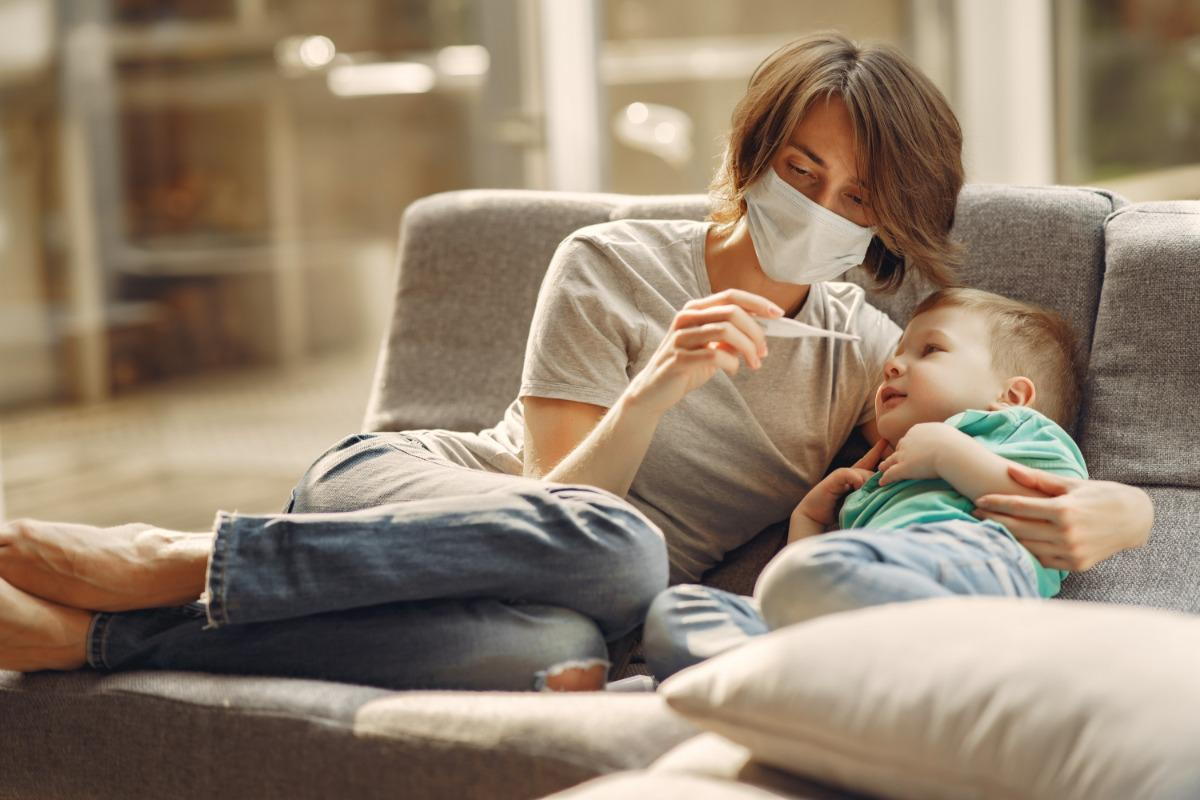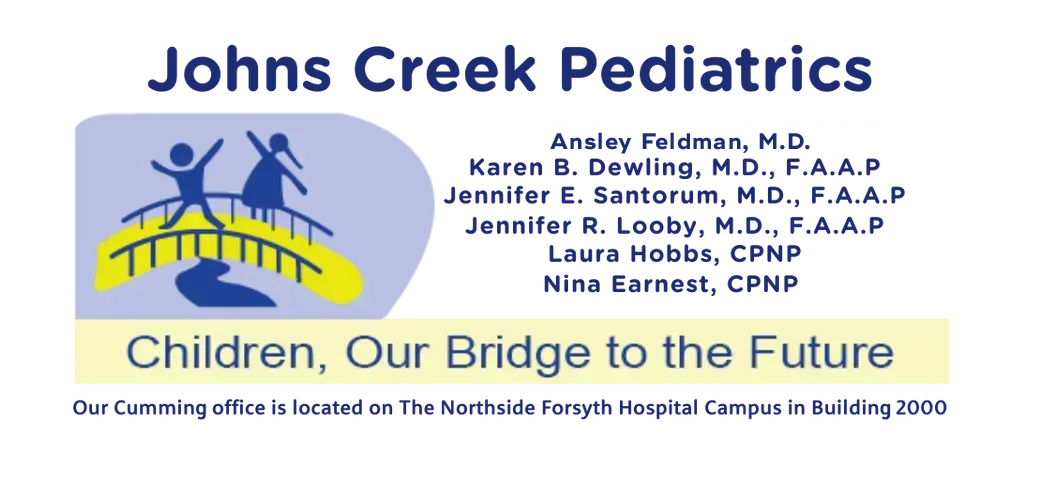Home Care for a Cold

- posted: Oct. 27, 2020
Upper respiratory infections, better known as colds, are one of the most common infections in children. Children can get an average of 7-10 colds a year! Colds are caused by viruses, and do not respond to antibiotics. Antibiotics are used to treat infections caused by bacteria. Your child’s cold symptoms can last a few days or as long as 10-14 days. Most colds can be treated at home. So, what can you do to help your little one feel better when they are sick?
Here are some of our favorite home care treatments:
- Encourage fluids and rest.
- Nasal saline- a salt water solution nasal spray that can help thin mucous and relieve nasal congestion (available over the counter).
- Steam therapy- using cool mist humidifier in child’s bedroom; or going into a small bathroom, shutting the door, turning on the shower on the highest setting, and letting the room fill with steam.
- Fever reducers- such as Tylenol or Motrin can be given for fevers (a temperature of 100.4 or higher).
If the treatments above aren’t helping enough, there are some additional treatments that can be tried based on your child’s age. Here are treatments by age:
- Newborns: Nasal saline, bulb suctioning, steam therapy
- 2 months +: Nasal saline, bulb suctioning, steam therapy, Baby Zarbees
- 3 months +: Nasal saline, bulb suctioning, steam therapy, Baby Zarbees, Vicks BabyRub
- 6 months +: Nasal saline, bulb suctioning, steam therapy, sips of warm water or juice, Baby Zarbees, Vicks BabyRub, Baby Hylands
- 1 year +: Nasal saline, bulb suctioning, steam therapy, Vicks BabyRub, Baby Zarbees or Children’s Zarbees, Baby Hylands, Honey
- 2 years +: Nasal saline, bulb suctioning, steam therapy, Vicks VapoRub, Children’s Zarbees, Children’s Hylands, Honey
- 6 years +: Nasal saline, blowing nose, steam therapy, Vicks VapoRub, Children’s Zarbees, Honey, Children’s cough suppressants containing dextromethorphan (Delsym), throat lozenges (breath mints or cough drops)
Your child can eat their regular diet. No special diet is needed. If they are having a sore throat however warm or cold fluids and foods can be soothing, such as warm tea/juices and popsicles/smoothies.
Things to avoid:
- Medicines not indicated for your child’s age- make sure to always read medication labels before giving to your child.
- Antihistamines- Allergy medicines such as Benadryl or Claritin are not proven to help treat cold symptoms. The only time we recommend taking antihistamines when your child is having a cold is if your child also has allergies and you think they could be having both allergy and cold symptoms.
Reasons to call our office:
- Fever (temperature of 100.4°F or higher) in an infant less than 2 months
- Fever (temperature of 100.4°F or higher) for > 3 days in children over 2 months
- Ear pain
- Difficulty breathing (child breathing faster than normal, nostrils flaring out when taking breaths, skin pulling tight at throat and ribs)
- Dehydration (pale skin, dry mouth, no tears when crying, not urinating 4 times a day (infants) or 3 times a day (older children).
- Any other concern

- posted: Oct. 27, 2020
Upper respiratory infections, better known as colds, are one of the most common infections in children. Children can get an average of 7-10 colds a year! Colds are caused by viruses, and do not respond to antibiotics. Antibiotics are used to treat infections caused by bacteria. Your child’s cold symptoms can last a few days or as long as 10-14 days. Most colds can be treated at home. So, what can you do to help your little one feel better when they are sick?
Here are some of our favorite home care treatments:
- Encourage fluids and rest.
- Nasal saline- a salt water solution nasal spray that can help thin mucous and relieve nasal congestion (available over the counter).
- Steam therapy- using cool mist humidifier in child’s bedroom; or going into a small bathroom, shutting the door, turning on the shower on the highest setting, and letting the room fill with steam.
- Fever reducers- such as Tylenol or Motrin can be given for fevers (a temperature of 100.4 or higher).
If the treatments above aren’t helping enough, there are some additional treatments that can be tried based on your child’s age. Here are treatments by age:
- Newborns: Nasal saline, bulb suctioning, steam therapy
- 2 months +: Nasal saline, bulb suctioning, steam therapy, Baby Zarbees
- 3 months +: Nasal saline, bulb suctioning, steam therapy, Baby Zarbees, Vicks BabyRub
- 6 months +: Nasal saline, bulb suctioning, steam therapy, sips of warm water or juice, Baby Zarbees, Vicks BabyRub, Baby Hylands
- 1 year +: Nasal saline, bulb suctioning, steam therapy, Vicks BabyRub, Baby Zarbees or Children’s Zarbees, Baby Hylands, Honey
- 2 years +: Nasal saline, bulb suctioning, steam therapy, Vicks VapoRub, Children’s Zarbees, Children’s Hylands, Honey
- 6 years +: Nasal saline, blowing nose, steam therapy, Vicks VapoRub, Children’s Zarbees, Honey, Children’s cough suppressants containing dextromethorphan (Delsym), throat lozenges (breath mints or cough drops)
Your child can eat their regular diet. No special diet is needed. If they are having a sore throat however warm or cold fluids and foods can be soothing, such as warm tea/juices and popsicles/smoothies.
Things to avoid:
- Medicines not indicated for your child’s age- make sure to always read medication labels before giving to your child.
- Antihistamines- Allergy medicines such as Benadryl or Claritin are not proven to help treat cold symptoms. The only time we recommend taking antihistamines when your child is having a cold is if your child also has allergies and you think they could be having both allergy and cold symptoms.
Reasons to call our office:
- Fever (temperature of 100.4°F or higher) in an infant less than 2 months
- Fever (temperature of 100.4°F or higher) for > 3 days in children over 2 months
- Ear pain
- Difficulty breathing (child breathing faster than normal, nostrils flaring out when taking breaths, skin pulling tight at throat and ribs)
- Dehydration (pale skin, dry mouth, no tears when crying, not urinating 4 times a day (infants) or 3 times a day (older children).
- Any other concern
Visit our Office
Suwanee Location
4395 Johns Creek Parkway
Suwanee, GA 30024
